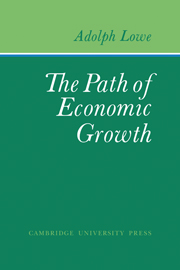Book contents
- Frontmatter
- Contents
- Preface
- Acknowledgments
- PART I The Basic Model
- 1 Introduction: Scope and Method
- 2 Patterns of Economic Growth
- 3 A Schema of Industrial Production
- 4 The Circulation of Fixed Capital
- 5 The Circulation of Working Capital
- 6 The Stationary Process in Operation: Structure Analysis
- 7 The Stationary Process in Operation: Force Analysis
- 8 Transition to Dynamic Equilibrium
- 9 Dynamic Equilibrium: Structure Analysis
- 10 Dynamic Equilibrium: Force Analysis
- PART II Changes in the Rate of Change
- PART III Changes in the Rate of Change
- PART IV Changes in the Rate of Change
- Appendix: An Alternative Presentation of Lowe's Basic Model
- Glossary of Recurring Symbols
- Name Index
- Subject Index
2 - Patterns of Economic Growth
Published online by Cambridge University Press: 07 October 2011
- Frontmatter
- Contents
- Preface
- Acknowledgments
- PART I The Basic Model
- 1 Introduction: Scope and Method
- 2 Patterns of Economic Growth
- 3 A Schema of Industrial Production
- 4 The Circulation of Fixed Capital
- 5 The Circulation of Working Capital
- 6 The Stationary Process in Operation: Structure Analysis
- 7 The Stationary Process in Operation: Force Analysis
- 8 Transition to Dynamic Equilibrium
- 9 Dynamic Equilibrium: Structure Analysis
- 10 Dynamic Equilibrium: Force Analysis
- PART II Changes in the Rate of Change
- PART III Changes in the Rate of Change
- PART IV Changes in the Rate of Change
- Appendix: An Alternative Presentation of Lowe's Basic Model
- Glossary of Recurring Symbols
- Name Index
- Subject Index
Summary
The most promising way of coming to grips with our problem is through a precise circumscription of the phenomenon of growth. To do so, we must first of all distinguish economic growth from economic change in general. The wider concept, change, is to refer to any conceivable alteration of an economic system, comprising not only expansions and contractions of aggregate states and processes, but also relative shifts within a constant aggregate as induced, for example, by a change in tastes. Of growth, on the other hand, we shall speak only when the system varies in the aggregate. This gives the term a broader meaning including also decline, covering not only contraction in the absolute sense but also a mere fall in the rate of growth. In order to isolate the particular problems in which we are interested, we shall narrow down this definition even further, excluding from it what, in the wake of Keynesian theory, has been labelled “changes in the level of activity.” Whereas the latter describe varying degrees of utilization of a given stock of resources, growth as here understood is bound up with changes in the size or the productivity of at least one resource factor.
In much of the literature the concept of growth is used in a still more restrictive sense, as applying only to per capita increases in output or consumption.
- Type
- Chapter
- Information
- The Path of Economic Growth , pp. 19 - 23Publisher: Cambridge University PressPrint publication year: 1976
- 1
- Cited by



